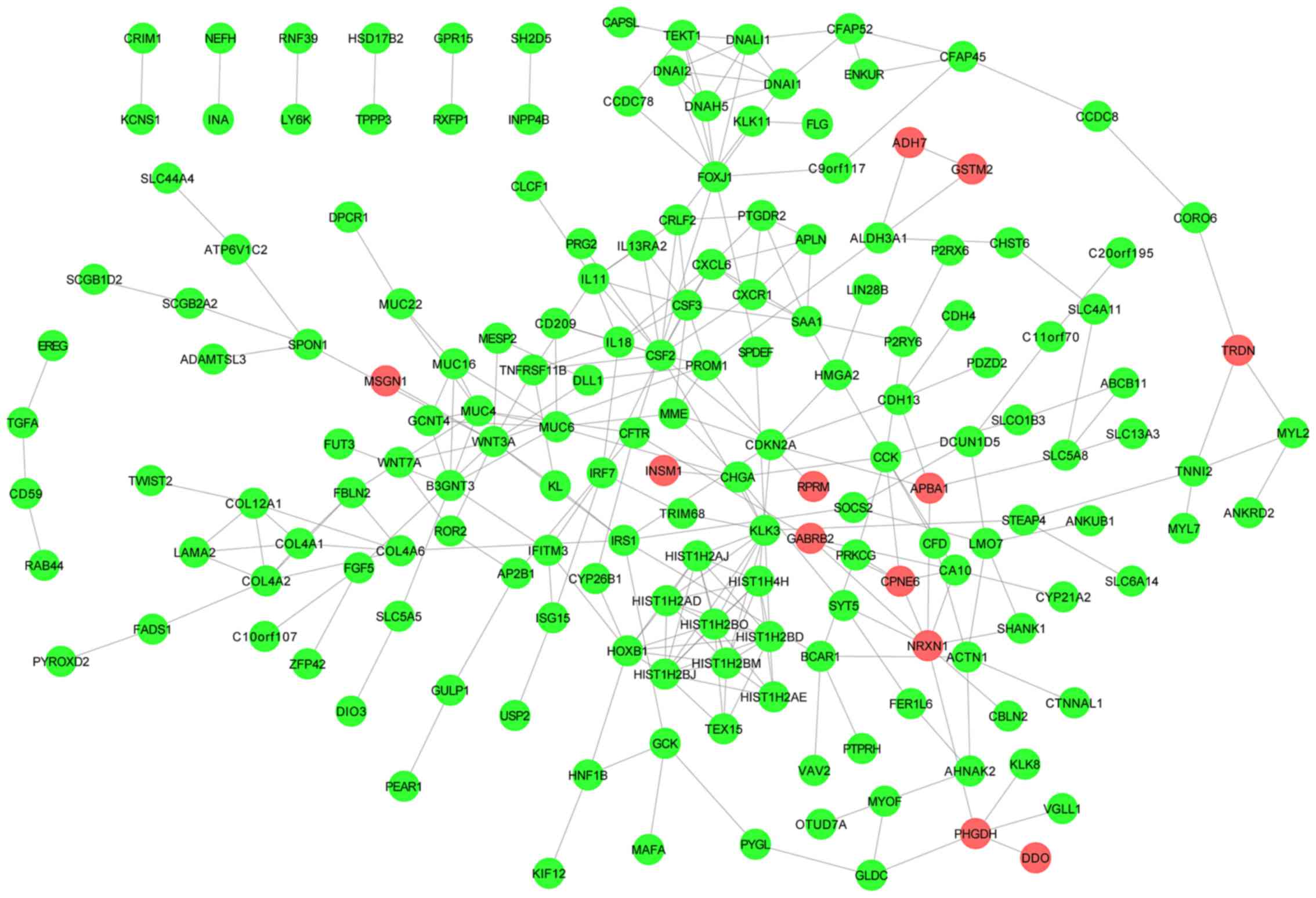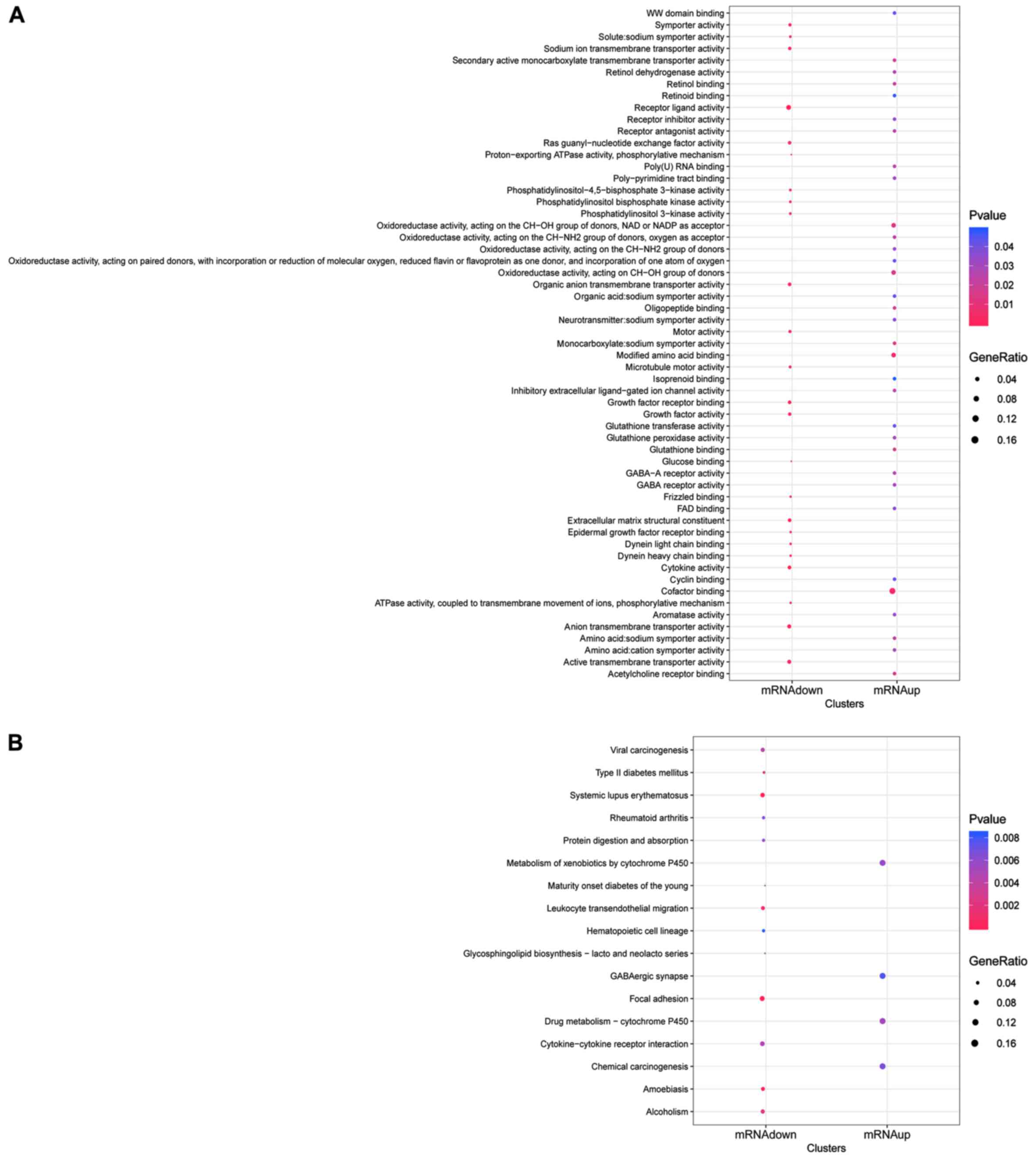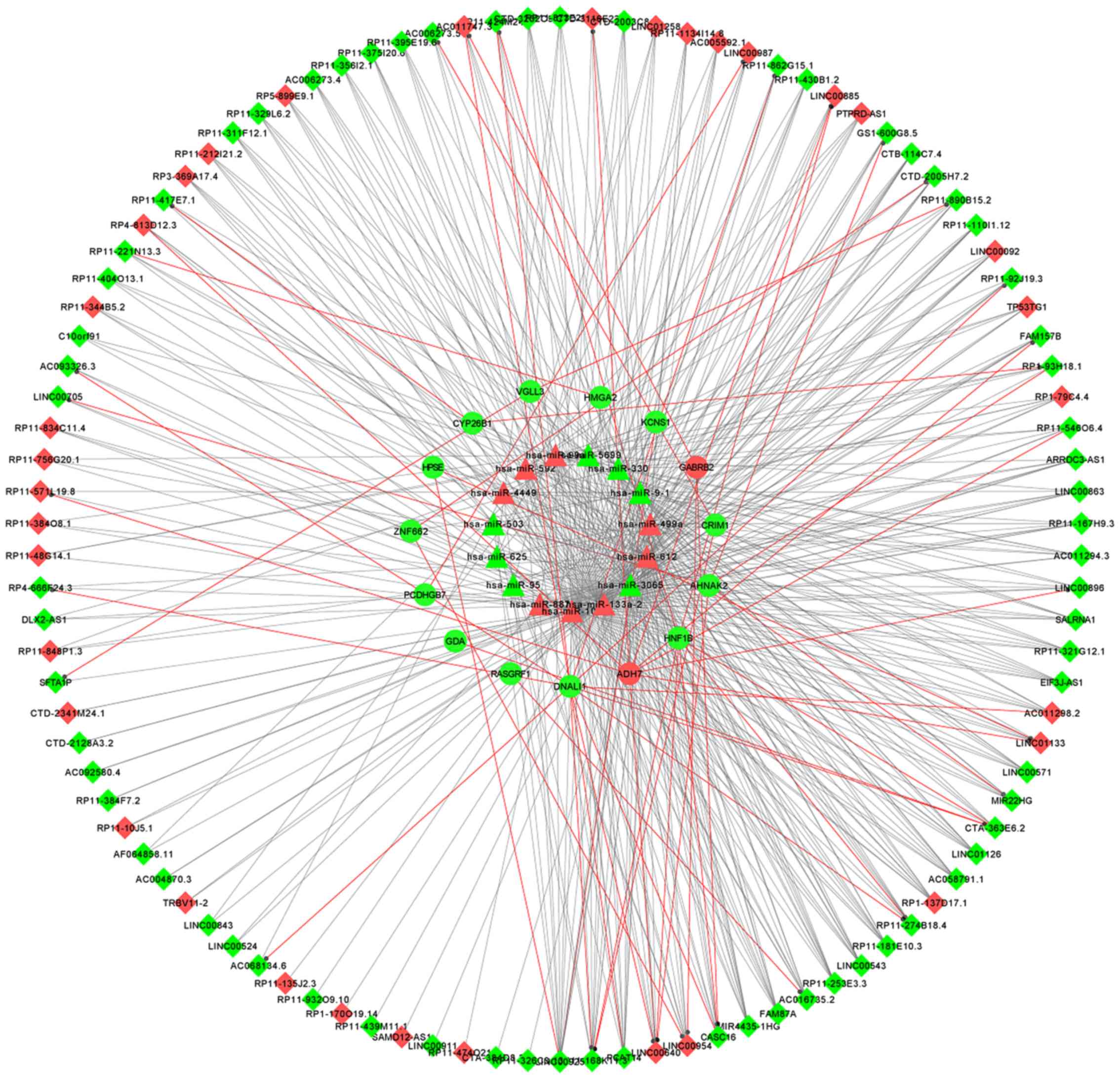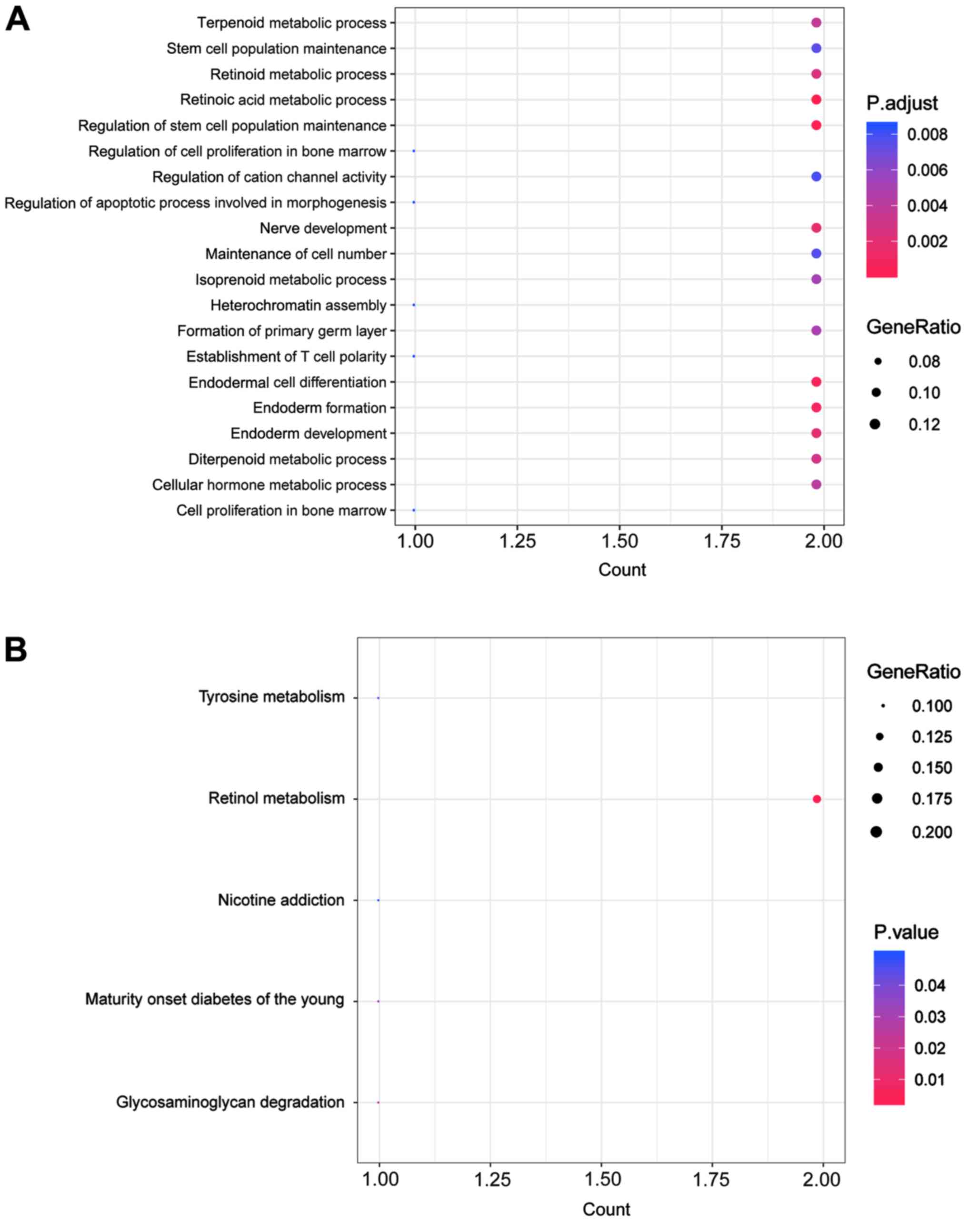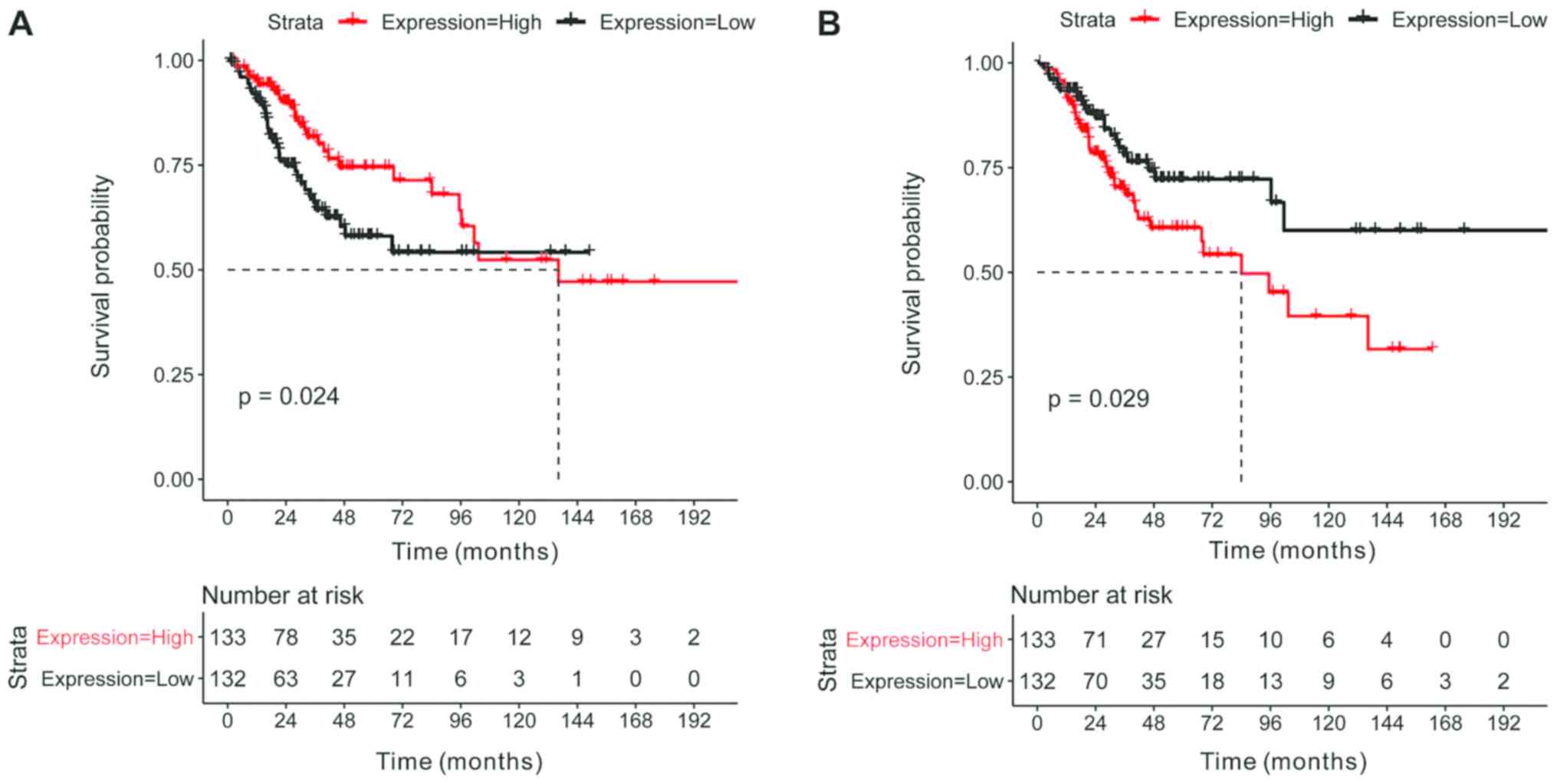|
1
|
Cotto KC, Wagner AH, Feng YY, Kiwala S,
Coffman AC, Spies G, Wollam A, Spies NC, Griffith OL and Griffith
M: DGIdb 3.0: A redesign and expansion of the drug-gene interaction
database. Nucleic Acids Res. 46:D1068–D1073. 2018. View Article : Google Scholar : PubMed/NCBI
|
|
2
|
Bray F, Ferlay J, Soerjomataram I, Siegel
RL, Torre LA and Jemal A: Global cancer statistics 2018: GLOBOCAN
estimates of incidence and mortality worldwide for 36 cancers in
185 countries. CA Cancer J Clin. 68:394–424. 2018. View Article : Google Scholar : PubMed/NCBI
|
|
3
|
de Lourdes Mora-García M, López-Cisneros
S, Gutiérrez-Serrano V, García-Rocha R, Weiss-Steider B,
Hernández-Montes J, Sánchez-Peña HI, Ávila-Ibarra LR, Don-López CA,
Muñóz-Godínez R, et al: HPV-16 infection is associated with a high
content of CD39 and CD73 ectonucleotidases in cervical samples from
patients with CIN-1. Mediators Inflamm. 7:46516272019.
|
|
4
|
Kjær SK, Munk C, Junge J and Iftner T:
Carcinogenic HPV prevalence and age-specific type distribution in
40,382 women with normal cervical cytology, ASCUS/LSIL, HSIL, or
cervical cancer: What is the potential for prevention? Cancer
Causes Control. 25:179–189. 2014. View Article : Google Scholar : PubMed/NCBI
|
|
5
|
Bruni L, Diaz M, Castellsagué X, Ferrer E,
Bosch FX and de Sanjosé S: Cervical human papillomavirus prevalence
in 5 continents: Meta-analysis of 1 million women with normal
cytological findings. J Infect Dis. 202:1789–1799. 2010. View Article : Google Scholar : PubMed/NCBI
|
|
6
|
Wheeler CM, Hunt WC, Cuzick J, Langsfeld
E, Pearse A, Montoya GD, Robertson M, Shearman CA and Castle PE;
New Mexico HPV Pap Registry Steering Committee, : A
population-based study of human papillomavirus genotype prevalence
in the United States: Baseline measures prior to mass human
papillomavirus vaccination. Int J Cancer. 132:198–207. 2013.
View Article : Google Scholar : PubMed/NCBI
|
|
7
|
Zhao P, Liu S, Zhong Z, Hou J, Lin L, Weng
R, Su L, Lei N, Hou T and Yang H: Prevalence and genotype
distribution of human papillomavirus infection among women in
northeastern Guangdong province of China. BMC Infect Dis.
18:2042018. View Article : Google Scholar : PubMed/NCBI
|
|
8
|
Luo G, Sun X, Li M, Liu T, Hu G, He Y, Mao
L, Yan L, Xie L, Zou H and Luo X: Cervical human papillomavirus
among women in Guangdong, China 2008–2017: Implication for
screening and vaccination. J Med Virol. 91:1856–1865. 2019.
View Article : Google Scholar : PubMed/NCBI
|
|
9
|
Wu C, Zhu X, Kang Y, Cao Y, Lu P, Zhou W,
Zhou H, Zhang Y and Song Y: Epidemiology of humanpapilloma virus
infection among women in Fujian, China. BMC Public Health.
18:952017. View Article : Google Scholar : PubMed/NCBI
|
|
10
|
Zhao FH, Tiggelaar SM, Hu SY, Xu LN, Hong
Y, Niyazi M, Gao XH, Ju LR, Zhang LQ, Feng XX, et al: A
multi-center survey of age of sexual debut and sexual behavior in
Chinese women: Suggestions for optimal age of human papillomavirus
vaccination in China. Cancer Epidemiol. 36:384–390. 2012.
View Article : Google Scholar : PubMed/NCBI
|
|
11
|
Dillner J, Rebolj M, Birembaut P, Petry
KU, Szarewski A, Munk C, de Sanjose S, Naucler P, Lloveras B, Kjaer
S, et al: Long term predictive values of cytology and human
papillomavirus testing in cervical cancer screening: Joint European
cohort study. BMJ. 337:969–972. 2008. View Article : Google Scholar
|
|
12
|
Biewenga P, van der Velden J, Mol BW,
Stalpers LJ, Schilthuis MS, van der Steeg JW, Burger MP and Buist
MR: Prognostic model for survival in patients with early stage
cervical cancer. Cancer. 117:768–776. 2011. View Article : Google Scholar : PubMed/NCBI
|
|
13
|
Kumar L, Pramanik R, Kumar S, Bhatla N and
Malik S: Neoadjuvant chemotherapy in gynaecological cancers -
Implications for staging. Best Pract Res Clin Obstet Gynaecol.
29:790–801. 2015. View Article : Google Scholar : PubMed/NCBI
|
|
14
|
Li N, Guo X, Liu L, Wang L and Cheng R:
Molecular mechanism of miR-204 regulates proliferation, apoptosis
and autophagy of cervical cancer cells by targeting ATF2. Artif
Cells Nanomed Biotechnol. 47:2529–2535. 2019. View Article : Google Scholar : PubMed/NCBI
|
|
15
|
Zhao YB, Wang JH, Chen XX, Wu YZ and Wu Q:
Values of three different preoperative regimens in comprehensive
treatment for young patients with stage Ib2 cervical cancer. Asian
Pac J Cancer Prev. 13:1487–1489. 2012. View Article : Google Scholar : PubMed/NCBI
|
|
16
|
Beresneva EV, Rykov SV, Hodyrev DS,
Pronina IV, Ermilova VD, Kazubskaia TP, Braga EA and Loginov VI:
Methylation profile of group of miRNA genes in clear cell renal
cell carcinoma; involvement in cancer progression. Genetika.
49:366–375, (In Russian). PubMed/NCBI
|
|
17
|
White NM, Khella HW, Grigull J, Adzovic S,
Youssef YM, Honey RJ, Stewart R, Pace KT, Bjarnason GA, Jewett MA,
et al: MiRNA profiling in metastatic renal cell carcinoma reveals a
tumour-suppressor effect for miR-215. Br J Cancer. 105:1741–1749.
2011. View Article : Google Scholar : PubMed/NCBI
|
|
18
|
Yang D and Zhang Q: MiR-152 may function
as an early diagnostic and prognostic biomarker in patients with
cervical intraepithelial neoplasia and patients with cervical
cancer. Oncol Lett. 17:5693–5698. 2019.PubMed/NCBI
|
|
19
|
Sun H, Fan G, Deng C and Wu L: MiR-4429
sensitized cervical cancer cells to irradiation by targeting RAD51.
J Cell Physiol. 23:185–193. 2020. View Article : Google Scholar
|
|
20
|
Mercer TR, Dinger ME and Mattick JS: Long
non-coding RNAs: Insights into functions. Nat Rev Genet.
10:155–159. 2009. View Article : Google Scholar : PubMed/NCBI
|
|
21
|
Sun L, Luo H, Liao Q, Bu D, Zhao G, Liu C,
Liu Y and Zhao Y: Systematic study of human long intergenic
non-coding RNAs and their impact on cancer. Sci China Life Sci.
56:324–334. 2013. View Article : Google Scholar : PubMed/NCBI
|
|
22
|
Peng L, Yuan X, Jiang B, Tang Z and Li GC:
LncRNAs: Key players and novel insights into cervical cancer.
Tumour Biol. 37:2779–2788. 2016. View Article : Google Scholar : PubMed/NCBI
|
|
23
|
Zhang JJ and Fan LP: Long non-coding RNA
CRNDE enhances cervical cancer progression by suppressing PUMA
expression. Biomed Pharmacother. 117:1087262019. View Article : Google Scholar : PubMed/NCBI
|
|
24
|
Yang XZ, Cheng TT, He QJ, Lei ZY, Chi J,
Tang Z, Liao QX, Zhang H, Zeng LS and Cui SZ: LINC01133 as ceRNA
inhibits gastric cancer progression by sponging miR-106a-3p to
regulate APC expression and the Wnt/β-catenin pathway. Mol Cancer.
17:1262018. View Article : Google Scholar : PubMed/NCBI
|
|
25
|
Karolchik D, Baertsch R, Diekhans M, Furey
TS, Hinrichs A, Lu YT, Roskin KM, Schwartz M, Sugnet CW, Thomas DJ,
et al: The UCSC genome browser database. Nucleic Acids Res.
31:51–54. 2003. View Article : Google Scholar : PubMed/NCBI
|
|
26
|
Mao X, Qin X, Li L, Zhou J, Zhou M, Li X,
Xu Y, Yuan L, Liu QN and Xing H: A 15-long non-coding RNA signature
to improve prognosis prediction of cervical squamous cell
carcinoma. Gynecol Oncol. 149:181–187. 2018. View Article : Google Scholar : PubMed/NCBI
|
|
27
|
Zerbino DR, Achuthan P, Akanni W, Amode
MR, Barrell D, Bhai J, Billis K, Cummins C, Gall A, Girón CG, et
al: Ensembl 2018. Nucleic Acids Res. 46:754–761. 2018. View Article : Google Scholar
|
|
28
|
Hubbard T, Barker D, Birney E, Cameron G,
Chen Y, Clark L, Cox T, Cuff J, Curwen V, Down T, et al: The
ensembl genome database project. Nucleic Acids Res. 30:38–41. 2002.
View Article : Google Scholar : PubMed/NCBI
|
|
29
|
Kumar L and E Futschik M: Mfuzz: A
software package for soft clustering of microarray data.
Bioinformation. 2:5–7. 2007. View Article : Google Scholar : PubMed/NCBI
|
|
30
|
Kanehisa M and Goto S: KEGG: Kyoto
encyclopaedia of genes and genomes. Nucleic Acids Res. 8:27–30.
2000. View Article : Google Scholar
|
|
31
|
Bolstad BM, Irizarry RA, Astrand M and
Speed TP: A comparison of normalization methods for high density
oligonucleotide array data based on variance and bias.
Bioinformatics. 22:185–193. 2003. View Article : Google Scholar
|
|
32
|
Breuer K, Foroushani AK, Laird MR, Chen C,
Sribnaia A, Lo R, Winsor GL, Hancock RE, Brinkman FS and Lynn DJ:
InnateDB: Systems biology of innate immunity and beyond-recent
updates and continuing curation. Nucleic Acids Res. 41:D1228–D1233.
2013. View Article : Google Scholar : PubMed/NCBI
|
|
33
|
Dweep H and Gretz N: MiRWalk2.0: A
comprehensive atlas of microRNA-target interactions. Nat Methods.
12:6972015. View Article : Google Scholar : PubMed/NCBI
|
|
34
|
Megiorni F, Cialfi S, Dominici C,
Quattrucci S and Pizzuti A: Synergistic post-transcriptional
regulation of the cystic fibrosis transmembrane conductance
regulator (CFTR) by miR-101 and miR-494 specific binding. PLoS One.
6:e266012011. View Article : Google Scholar : PubMed/NCBI
|
|
35
|
Hansen TB, Jensen TI, Clausen BH, Bramsen
JB, Finsen B, Damgaard CK and Kjems J: Natural RNA circles function
as efficient microRNA sponges. Nature. 495:384–388. 2013.
View Article : Google Scholar : PubMed/NCBI
|
|
36
|
Paraskevopoulou MD and Hatzigeorgiou AG:
Analyzing MiRNA-LncRNA interactions. Methods Mol Biol.
1402:271–286. 2016. View Article : Google Scholar : PubMed/NCBI
|
|
37
|
Sporn MB and Roberts AB: Role of retinoids
in differentiation and carcinogenesis. Cancer Res. 43:3034–3040.
1983.PubMed/NCBI
|
|
38
|
Abu J, Batuwangala M, Herbert K and
Symonds P: Retinoic acid and retinoid receptors: Potential
chemopreventive and therapeutic role in cervical cancer. Lancet
Oncol. 6:712–720. 2005. View Article : Google Scholar : PubMed/NCBI
|
|
39
|
Gariglio P, Gutiérrez J, Cortés E and
Vázquez J: The role of retinoid deficiency and estrogens as
cofactors in cervical cancer. Arch Med Res. 40:449–465. 2009.
View Article : Google Scholar : PubMed/NCBI
|
|
40
|
Liu P, Chen N and Yang X: The effect of
retinol metabolism related genes LRAT/RDH12 in the progress of
squamous cervical cancer cell line. Prog Obstet Gynecol. 2018.
|
|
41
|
Jelski W, Chrostek L, Zalewski B and
Szmitkowski M: Alcohol dehydrogenase (ADH) isoenzymes and aldehyde
dehydrogenase (ALDH) activity in the sera of patients with gastric
cancer. Dig Dis Sci. 53:2101–2105. 2008. View Article : Google Scholar : PubMed/NCBI
|
|
42
|
Osanai M and Lee GH: Increased expression
of the retinoic acid-metabolizing enzyme CYP26A1 during the
progression of cervical squamous neoplasia and head and neck
cancer. BMC Res Notes. 7:1–9. 2014. View Article : Google Scholar : PubMed/NCBI
|
|
43
|
Kabirizadeh S, Azadeh M, Mirhosseini M,
Ghaedi K and Tanha HM: The SNP rs3746444 within mir-499a is
associated with breast cancer risk in Iranian population. J Cell
Immunother. 2:95–97. 2016. View Article : Google Scholar
|
|
44
|
Wang XH, Wang FR, Tang YF, Zou HZ and Zhao
YQ: Association of miR-149C>T and miR-499A>G polymorphisms
with the risk of hepatocellular carcinoma in the Chinese
population. Genet Mol Res. 13:5048–5054. 2014. View Article : Google Scholar : PubMed/NCBI
|
|
45
|
Xiang Z, Wang S and Xiang Y: Upregulated
MicroRNA499a by hepatitis B virus induced hepatocellular
carcinogenesis via targeting MAPK6. PLoS One. 9:e1114102014.
View Article : Google Scholar : PubMed/NCBI
|
|
46
|
He S, Li Z, Yu Y, Zeng Q, Cheng Y, Ji W,
Xia W and Lu S: Exosomal miR-499a-5p promotes cell proliferation,
migration and EMT via mTOR signaling pathway in lung
adenocarcinoma. Exp Cell Res. 379:203–213. 2019. View Article : Google Scholar : PubMed/NCBI
|
|
47
|
Cui L, Nai M, Zhang K, Li L and Li R:
lncRNA WT1-AS inhibits the aggressiveness of cervical cancer cell
via regulating p53 expression via sponging miR-330-5p. Cancer Manag
Res. 11:651–667. 2019. View Article : Google Scholar : PubMed/NCBI
|
|
48
|
Zhang W, Du M, Wang T, Chen W, Wu J, Li Q,
Tian X, Qian L, Wang Y, Peng F, et al: Long non-coding RNA
LINC01133 mediates nasopharyngeal carcinoma tumorigenesis by
binding to YBX1. Am J Cancer Res. 9:779–790. 2019.PubMed/NCBI
|
|
49
|
Zheng YF, Zhang XY and Bu YZ: LINC01133
aggravates the progression of hepatocellular carcinoma by
activating the PI3K/AKT pathway. J Cell Biochem. 120:4172–4179.
2019. View Article : Google Scholar : PubMed/NCBI
|
|
50
|
Zhang J, Zhu N and Chen X: A novel long
noncoding RNA LINC01133 is upregulated in lung squamous cell cancer
and predicts survival. Tumor Biol. 36:7465–7471. 2015. View Article : Google Scholar
|
|
51
|
Müller S and Nowak K: Exploring the
miRNA-mRNA regulatory network in clear cell renal cell carcinomas
by next-generation sequencing expression profiles. Biomed Res Int.
2014:948408. 2014. View Article : Google Scholar : PubMed/NCBI
|















